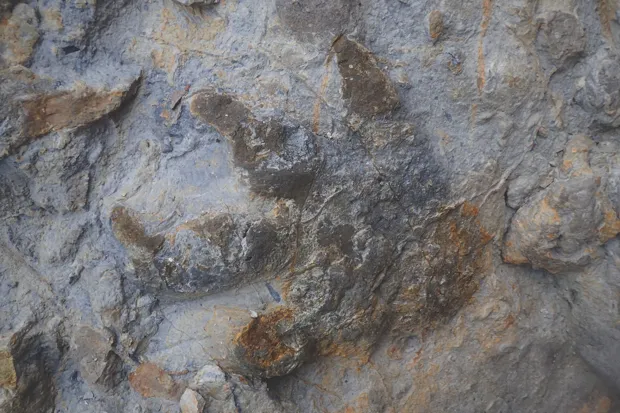Researchers from the University of Cambridge have identified an area of fossilised dinosaur footprints. Discovered on a section of coastal erosion along cliffs near Hastings, East Sussex, the prints are the most diverse and detailed ever found in the UK.
The footprints date from the Early Cretaceous, which stretches from 101 to 145 million years ago. There are prints from Iguanodon, Ankylosaurus, a species of stegosaur, possible sauropods (the large leaf-eating group of dinosaurs that includes Diplodocus), and theropods (the group of meat-eating dinosaurs that includes Velociraptor).
“Whole body fossils of dinosaurs are incredibly rare,” said PhD student Anthony Shillito, who took part in the research. “Usually you only get small pieces, which don’t tell you a lot about how that dinosaur may have lived. A collection of footprints like this helps you fill in some of the gaps and infer things about which dinosaurs were living in the same place at the same time.”
The area around Hastings is one of the richest sources of dinosaur fossils in the UK. The first known Iguanodon fossil was found in the area back in 1825, and the first confirmed example of fossilised dinosaur brain tissue was uncovered in 2016.
The prints range in size from less than 2cm to more than 60cm across. Some are so beautifully preserved that the intricate details of the dinosaurs’ skin, scales and claws are easily visible.
“You can get some idea about which dinosaurs made them from the shape of the footprints – comparing them with what we know about dinosaur feet from other fossils lets you identify the important similarities,” said Shillito. “When you also look at footprints from other locations you can start to piece together which species were the key players.”
It’s likely that the site was once a water source as a number of fossilised plants and invertebrates were also found in the immediate area. The wet ground would also have helped to capture and preserve the footprints.
It’s possible that there are many more dinosaur footprints hidden within the eroding sandstone cliffs found on the coast of East Sussex, but sea defences recently built in the area may make them difficult to find.
Iguanodon

The Iguanodon, meaning ‘iguana tooth’, was a plant-eating dinosaur that lived around 125 million years ago. It was first discovered back in 1822 by the English geologist Gideon Mantell and was the second dinosaur to be named (the first was the Megalosaurus). Iguanodon could reach roughly 10 metres in length, weighed around 3.5 tonnes and could achieve speeds of up to 24km/h (15mph).
Ankylosaurus

The Ankylosaurus, meaning ‘fused lizard’, was a plant-eating dinosaur that lived around 65 million years ago. It reached about nine metres in length, weighed around six tonnes, and was covered in distinctive body armour. It had a large club-like structure on the end of its tail that it possibly used to strike other dinosaurs when defending itself.
This is an extract from issue 331 of BBC Focus magazine.
Subscribe and get the full article delivered to your door, or download the BBC Focus app to read it on your smartphone or tablet. Find out more
Follow Science Focus onTwitter,Facebook, Instagramand Flipboard